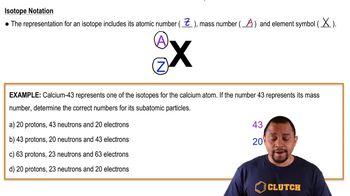Textbook Question
Consider an atom of 10B. (c) What is the symbol of the atom obtained by adding one neutron to 10B?
5
views
 Verified step by step guidance
Verified step by step guidance



Consider an atom of 10B. (c) What is the symbol of the atom obtained by adding one neutron to 10B?
Consider an atom of 10B. (d) Are either of the atoms obtained in parts (b) and (c) isotopes of 10B? If so which one?
Consider an atom of 63Cu. (a) How many protons, neutrons, and electrons does this atom contain?
Consider an atom of 63Cu. (c) What is the symbol for the isotope of 63Cu that possesses 36 neutrons?
(a) Define atomic number and mass number.
(b) Which of these can vary without changing the identity of the element?